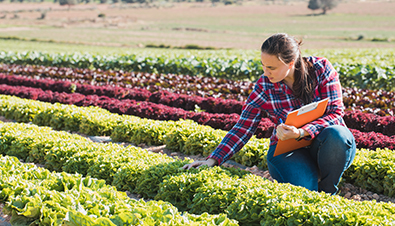Read the latest information on
Foot-and-mouth disease

More and more, the records that you keep for one purpose in your business – like records of crop monitoring – can be used for biosecurity purposes too.
If you sometimes feel like you are drowning in paperwork, be reassured that keeping records is a genuinely useful biosecurity practice.
If you ever find yourself caught up in a pest or disease incursion, the records you keep will be invaluable both to you and other producers in your industry.
Keeping records of people who have come and gone from your property, particularly those who entered production areas is an important biosecurity practice. This information may be used to determine the origin and potential spread of a pest or disease that can be carried on clothes or shoes of visitors.
Visitor records might also tell you when your property first became infected, for example after hosting a field day or during harvest on a U-pick farm.
Noting when planting material or new stock is brought onto the property is another key piece of information that can be useful when working out where a disease has come from.
This should include:
Come the end of the production cycle, you should be able to say where the product went when it left the property so biosecurity officers can trace where it might have ended up.
More and more, the records that you keep for one purpose in your business can be used for biosecurity purposes too.

It doesn’t really matter what physical form your records take: they can be paper copies or electronic spread sheets or programs
Tracking systems used for food security or determining provenance of product are increasingly being sought by markets. Many businesses rely on being able to trace a product from paddock to plate to reassure customers that the product is genuine and managed in a particular way. These records can be useful in an incursion too.
For example, if your orchard or the nursery providing your trees is accredited (ie maintains a quality assured scheme, such as ISO9000, SQF 2000, NIASA, Freshcare, or Woolworths Quality Assurance Scheme, BioSecure HACCP, and the Greenlife Industry Australia biosecurity QA system), it is likely that some fundamental techniques of biosecurity best practice are being used.
Ensure that your scheme and your records allow full traceability. Records of surveillance and pest management practices (including spray diaries) are also important and should be kept.
It doesn’t really matter what physical form your records take: they can be paper copies or electronic spread sheets or programs. What is important is that it is in order when it is filed away so that in an incursion you can find the information requested of you quickly. Time is important when establishing how far a pest may have spread and prompt answers help improve the chances of eradication.
Other business records may be used to identify the value of crops or goods removed under an eradication program.
For example, you may be reimbursed for the value of your crop and your irrigation system if they are removed as part of an agreed response plan to eradicate a pest. It’s easier if you have that information available when it comes time to lodge a claim for reimbursement.
The important thing is that you need to keep auditable records that show the value of your crops and infrastructure.
For a list of biosecurity records suitable for your industry, go to the profiler page, select the crops (or livestock) that apply to you and save. The biosecurity resources relevant to you will be collected from the site and listed in the results.